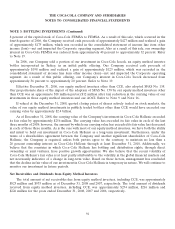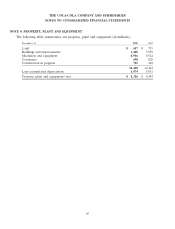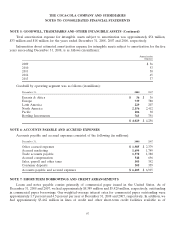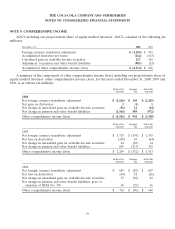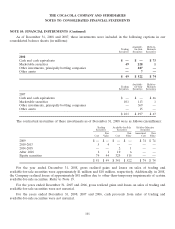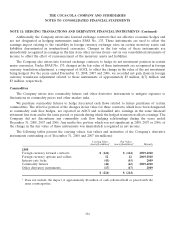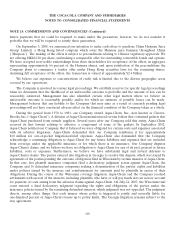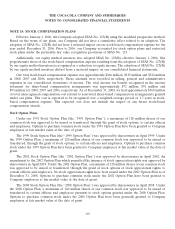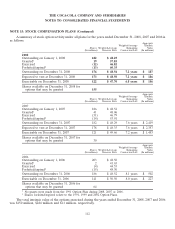Coca Cola 2008 Annual Report Download - page 104
Download and view the complete annual report
Please find page 104 of the 2008 Coca Cola annual report below. You can navigate through the pages in the report by either clicking on the pages listed below, or by using the keyword search tool below to find specific information within the annual report.THE COCA-COLA COMPANY AND SUBSIDIARIES
NOTES TO CONSOLIDATED FINANCIAL STATEMENTS
NOTE 10: FINANCIAL INSTRUMENTS (Continued)
Fair Value of Other Financial Instruments
The carrying amounts of cash and cash equivalents, receivables, accounts payable and accrued expenses,
and loans and notes payable approximate their fair values because of the relatively short-term maturity of these
instruments.
We carry our cost method investments at cost. If a decline in the fair value of a cost method investment is
determined to be other than temporary, an impairment charge is recorded and the fair value becomes the new
cost basis of the investment. We evaluate all of our cost method investments for impairment; however, we are
not required to determine the fair value of our investment unless impairment indicators are present. When
impairment indicators exist, we generally use discounted cash flow analyses to determine the fair value.
We estimate that the fair values of cost method investments approximate their carrying amounts. As of
December 31, 2008 and 2007, our cost method investments had a carrying value of approximately $176 million
and $119 million, respectively.
We recognize all derivative instruments as either assets or liabilities at fair value in our consolidated balance
sheets, with fair values estimated based on quoted market prices or pricing models using current market rates.
Virtually all of our derivatives are straightforward, over-the-counter instruments with liquid markets. For further
discussion of our derivatives, including a disclosure of derivative values, refer to Note 11 and Note 12.
The fair value of our long-term debt is estimated based on quoted prices for those or similar instruments.
As of December 31, 2008, the carrying amounts and fair values of our long-term debt, including the current
portion, were approximately $3,246 million and $3,402 million, respectively. As of December 31, 2007, these
carrying amounts and fair values were approximately $3,410 million and $3,416 million, respectively.
NOTE 11: HEDGING TRANSACTIONS AND DERIVATIVE FINANCIAL INSTRUMENTS
When deemed appropriate, our Company uses derivative financial instruments primarily to reduce our
exposure to adverse fluctuations in interest rates and foreign currency exchange rates, commodity prices and
other market risks. The Company formally designates and documents the financial instrument as a hedge of a
specific underlying exposure, as well as the risk management objectives and strategies for undertaking the hedge
transactions. The Company formally assesses, both at the inception and at least quarterly thereafter, whether the
financial instruments that are used in hedging transactions are effective at offsetting changes in either the fair
value or cash flows of the related underlying exposure. Because of the high degree of effectiveness between the
hedging instrument and the underlying exposure being hedged, fluctuations in the value of the derivative
instruments are generally offset by changes in the fair values or cash flows of the underlying exposures being
hedged. Any ineffective portion of a financial instrument’s change in fair value is immediately recognized in
earnings. Virtually all of our derivatives are straightforward over-the-counter instruments with liquid markets.
Our Company does not enter into derivative financial instruments for trading purposes.
The fair values of derivatives used to hedge or modify our risks fluctuate over time, and are determined in
accordance with SFAS No. 157. Refer to Note 12. We do not view these fair value amounts in isolation, but
rather in relation to the fair values or cash flows of the underlying hedged transactions or other exposures. The
notional amounts of the derivative financial instruments do not necessarily represent amounts exchanged by the
parties and, therefore, are not a direct measure of our exposure to the financial risks described above. The
amounts exchanged are calculated by reference to the notional amounts and by other terms of the derivatives,
such as interest rates, foreign currency exchange rates or other financial indices.
102




